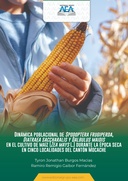Explore

Dinámica poblacional de Spodoptera frugiperda, Diatraea saccharalis y Dalbulus maidis en el cultivo de maíz (Zea mays L.) durante la época seca en cinco localidades del cantón Mocache
0 Ungluers have
Faved this Work
Login to Fave
The manuscript entitled “Population dynamics of Spodoptera frugiperda, Diatraea saccharalis and Dalbulus maidis in maize (Zea mays L.) during the dry season in five localities of Mocache canton” deals with a study on maize, which is affected by these pests, being a limiting factor in production. It highlights the consequences of the excessive use of insecticides, such as pest resistance and environmental contamination, and proposes integrated pest management (IPM) as a sustainable alternative. The study includes the use of traps for pest monitoring and control, a key tool for decision-making in crop management. The methodology employed in the research includes the localization of the study in five locations, the use of descriptive and correlational methods, and the analysis of variables such as climatic data, percentage of infestation, number of specimens captured per trap, presence of beneficial insects, and correlations between these variables. The results obtained reveal the infestation of Spodoptera frugiperda, Diatraea saccharalis and Dalbulus maidis in the localities studied, the population fluctuation of these pests and their relationship with climatic factors, and the efficiency of light traps and sticky traps to capture adults of these species. In addition, the presence of beneficial insects in the study area is reported. The discussion analyzes the impact of these findings in the context of pest management in corn crops. Finally, conclusions and recommendations focus on strategies to improve pest control and sustainability of maize production in areas affected by these pests.
This book is included in DOAB.
Why read this book? Have your say.
You must be logged in to comment.
